
Cutting
in two of the Swiss m.s. "Nyon"
an unusual salvage job

In november 1958 a job of very interesting character was carryied out by our tugs "Simson" and "Hector"and two British tugs, the "George V" and "Beamish". This was the salvage and the cutting in half of the Swiss motorship "Nyon", 4956 tons gross, which went aground in a dense fog off St. Abb's Head , Scotland and bottom was badly punctured. Attemps to refloat the vessel by the usual methods having proved unsuccessful, it was decided tosave the after part which contained the main and auxiliary machinery.
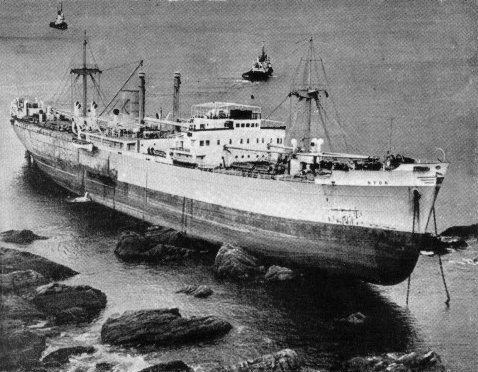
The m.s. "Nyon"aground in november 1985
The "Nyon" had given mayday signals and asked for tug assistance on saturday november 15th. 1958. The two British tugs were at first on the place of distress, but the master of the "Nyon" knew they needed havy salvage equipment and accepted our services on Lloyd's Open Form of Salvage Agreement. Our tugs "Simson" and "Hector", equipped with heavy pumps, divers etc. were proceeding and also two salvage inspectors were flying out to Edinburgh.
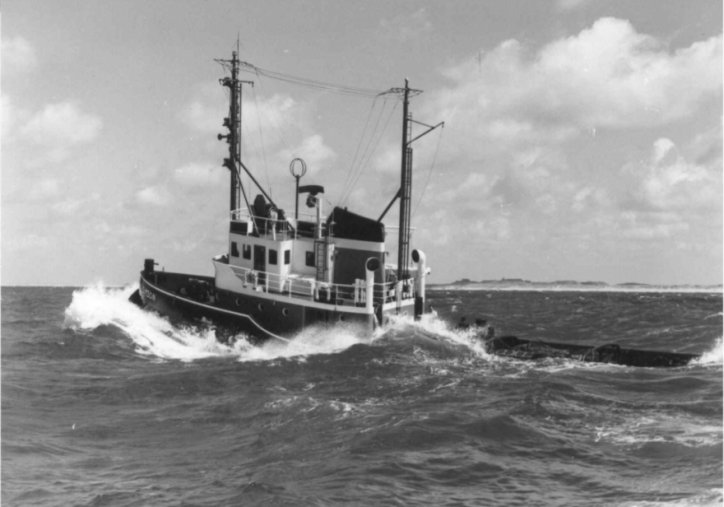
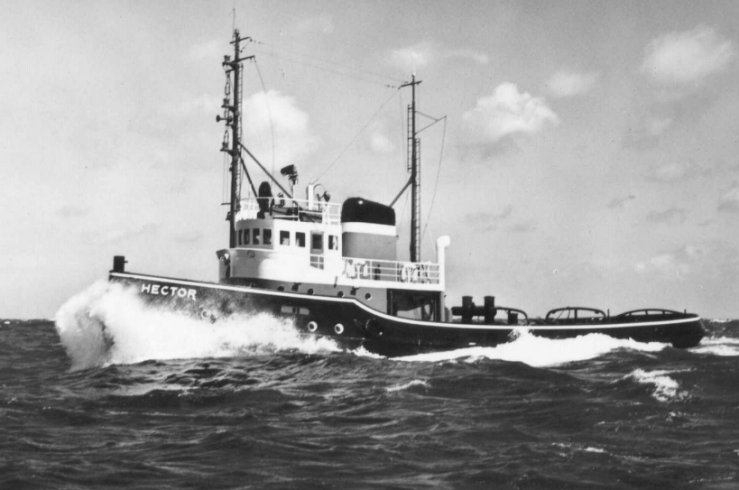
The Simson en Hector were proceeding to the Nyon
After arrival the tugs started immediately
to transfer salvage equipment to the "Nyon". Both connected and commenced
towing, but the "Nyon" did not move.
The ship was very badly leaking and much more pump was needed. More pumps, bottles of
oxygen and of gas, burning equipment and steelplates were brought on board the
"Nyon". Our men tried to close the holes by putting several tons of cement in
the bilges at low tide, but this was all destroyed by the working of the "Nyon".
The holds, I, II and III were tidal. All pumps were put into action but without
any effect.
In the opinion of all salvors it was impossible to save the whole ship. Each tide was
causing great deterioration to her structure and unless prompt steps were taken to sever
the valuable afterpart from the forepart the whole would soon become a total loss. On
november 21st. all our men commenced to move and make fast on the afterpart of the
"Nyon" all pumps, barrels of oil etc. from the forepart. They commenced also to
dismantle and remove all valuable instruments, such as the giro compass, the automatic
pilot, echo sounder, radio set, new ropes and wires, etc. etc.
The first operation was to weld the hatch bridle beams, and stiffen the deeptank bulkhead
and the tank top. At low tide it was possible to gain access to fractures in the deep tank
which were welded, and at the same time plates were fabricated for cement boxes. Flame
cutting was commenced when all water and oil pipes leading from the tunnel to the engine
room were cut and wood plugged. One half of the tunnel was welded first, the tunnel then
baled free of water and the second section plate fitted and welded.
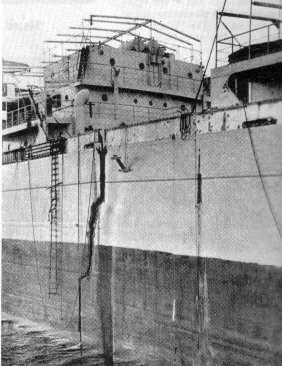 During the morning of november 23rd. the burners started cutting
the hull on both sides. After some hours the sides of the hull had been cut right across.
After this all tugs - the two British tugs "George V"and "Beamis" were
contracted by Wijsmuller to assist the "Simson"and "Hector" - made
fast on the afterpart and started towing at full power, sheering from port to starboard as
much as possible in an endeavour to fracture the bottom plates, but without success.
During the morning of november 23rd. the burners started cutting
the hull on both sides. After some hours the sides of the hull had been cut right across.
After this all tugs - the two British tugs "George V"and "Beamis" were
contracted by Wijsmuller to assist the "Simson"and "Hector" - made
fast on the afterpart and started towing at full power, sheering from port to starboard as
much as possible in an endeavour to fracture the bottom plates, but without success.
Expectations that the rise and fall of the stern half with the tide would fracture the
keel plates also did not materialise. At low tide the cut opened to 2½ feet on the deck
and 1½ feet down the sites. As it appeared that in the calm weather conditions prevailing
it would be a long time even with the efforts of the tugs before the bottom plates parted
at the cuts, it was decided to obtain light explosives.
On november25th. the first of explosives and sand were lowered and exploded. More packets
were exploded, while the tugs were continually fast to the afterpart and kept on tugging.
The bottom plating still held. Further sets of explosives were placed and exploded. With
the rising tide on november 27th. the afterpart started working.
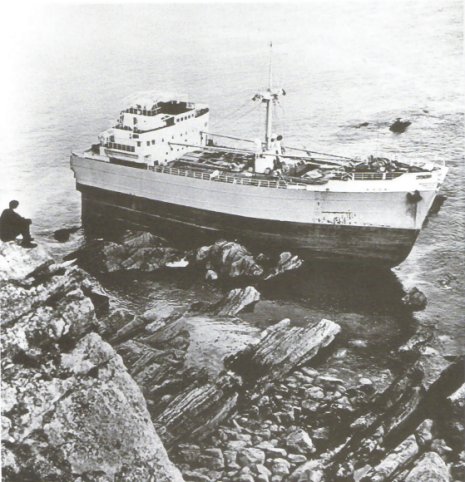 All tugs were now ordered to pull at full power and sheer to
starboard as much as possible. This caused the afterpart to come away about 10 degrees to
port of the forepart. The tugs kept pulling and sheering and with a light swell the
afterpart was lively so much that the starboard side opened and theafterpart came free.
The tugs pulled the afterpart slowly and carefully away from the coast into deeper
water and round St. Abb's Head in order to make course toward the Tyne. The afterpart of
the "Nyon" was not leaking and the stability and buoyancy were all right. On
november 28th. the tow arrived at Smit's Dockyard, North Shields.
All tugs were now ordered to pull at full power and sheer to
starboard as much as possible. This caused the afterpart to come away about 10 degrees to
port of the forepart. The tugs kept pulling and sheering and with a light swell the
afterpart was lively so much that the starboard side opened and theafterpart came free.
The tugs pulled the afterpart slowly and carefully away from the coast into deeper
water and round St. Abb's Head in order to make course toward the Tyne. The afterpart of
the "Nyon" was not leaking and the stability and buoyancy were all right. On
november 28th. the tow arrived at Smit's Dockyard, North Shields.
Some days later the forepart of the "Nyon" was fully dstroyed by a heavy
gale......!
On saturday, november 29th. the "Simson"and "Hector" went back
to Ymuiden, after two weeks hard working under difficuld circumstances the crew members
cleared this unusual salvage job, they going home, waiting for the next job.
The abandoned part after a winter galeAfter the successfully salvage of the afterpart the Owners of the "Nyon"decided to compleet the ship and lengthened the hull with 5½ yards. The contract for the reconstruction of the "Nyon" was awarded to the Dutch yard N.V. Boeles Shipyards at Bolnes and by the middle of 1959 the ship made her trials.
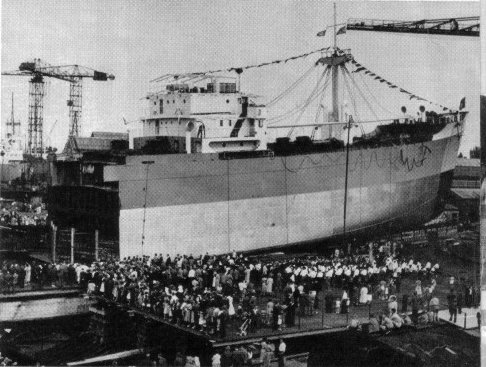
The new forepart being launched
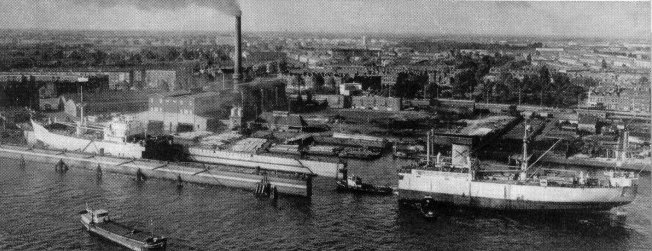
The two halves being put together in a floating drydock at N.V. Boeles Shipyards,
Bolnes
The renewed "Nyon" which had so much care and expertation, was'nt allotted a long live, on june 15th. 1962 at her voyage from Antwerpen to Montreal (Can.) the ship was perished after a collision in a dense fog with the Indian m.s. "Jalazad", at five miles of Beachy Head (Eng.)
![]()